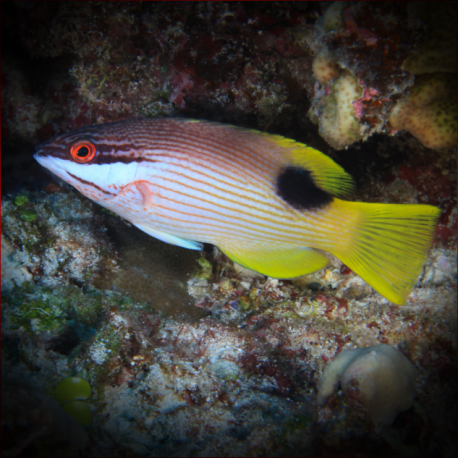More info
Datasheet
| Minimum Tank Size | 1500 litres / 396.26 US gallons |
| Maximum Size | 55.0cm / 21.65inches |
| Reef Compatible | Reef safe with caution |
| Temperament | Might be aggressive towards other species |
| Temperature | 22.2°C / 71.96°F - 25.6°C / 78.08°F |
| Specific Gravity | 1.020-1.025 |
| Carbonate Hardness | 8-12 |
| pH | 8.1-8.4 |
General Description:
Saddleback Hogfish, also known as Bodianus bilunulatus, are members of the Labridae family, commonly found in the Indo-West Pacific region, spanning from the east coast of Africa to Japan, the Philippines, and New Caledonia. These fish are recognized for their distinctive hunting behavior, where they use their snouts to forage for food in the substrate, often trailing other fish that have disturbed the sand.
Aquarium Suitability:
Considered suitable for aquariums, Saddleback Hogfish require careful attention due to their potential aggression towards other species, especially when fully grown. They are known to hunt crustaceans, sea urchins, and worms effectively in an aquarium setting, making them a challenging choice for mixed species tanks. These fish demand a large living space, as their natural foraging behavior can quickly deplete sand resources within the tank. Maintaining hiding spots, such as live rocks, is crucial for their well-being.
Care and Hardiness:
Saddleback Hogfish exhibit hardy traits and can adapt to various water conditions. However, they tend to hide for extended periods, particularly in the presence of aggressive tank mates. These fish prefer ample space for swimming, making them unsuitable for small or crowded aquariums. Their aggressive tendencies towards invertebrates and potentially similar-looking species should be carefully monitored.
Reef Suitability:
Reef enthusiasts should exercise caution when considering Saddleback Hogfish for their tanks. While classified as "reef safe with caution," these fish can disturb the substrate, potentially causing water cloudiness and detritus buildup. Their preference for hunting invertebrates may not align with maintaining a harmonious reef ecosystem.
Aquarium Setup:
Creating an ideal aquarium setup for Saddleback Hogfish involves providing sufficient space for swimming and exploring. Including hiding places, such as live rocks, is crucial for their sense of security. It is recommended to introduce more aggressive tank mates only after these fish have acclimatized to their new environment to prevent stress-induced behaviors.
Behaviour:
Saddleback Hogfish can display initially shy behavior in a new aquarium setup. Understanding their tendency for aggression towards certain species and their hunting habits is essential for maintaining a balanced tank environment. These fish are active swimmers and benefit from an aquarium layout that allows them to move freely.
Feeding and Diet:
When it comes to feeding, Saddleback Hogfish have a diverse diet that includes larger crustaceans, various invertebrates, small crustaceans like krill and mysis, and zooplankton such as Cyclops and pods. Ensuring a well-rounded diet is essential for their health and vitality.
Dimorphism:
One intriguing aspect of Saddleback Hogfish is their hermaphroditic nature. These fish have the ability to change gender from female to male as needed, facilitating breeding dynamics within a group. Understanding this unique trait can provide insights into their captive reproduction potential.
Habitat and Distribution:
In their natural habitat, Saddleback Hogfish are commonly found in the East Indian Ocean, West Indian Ocean, Australia, Indonesia, and the Central/West Pacific region. Their distribution ranges from the coastal waters of Africa to the distant shores of Japan and New Caledonia, reflecting their adaptability to diverse marine environments.

